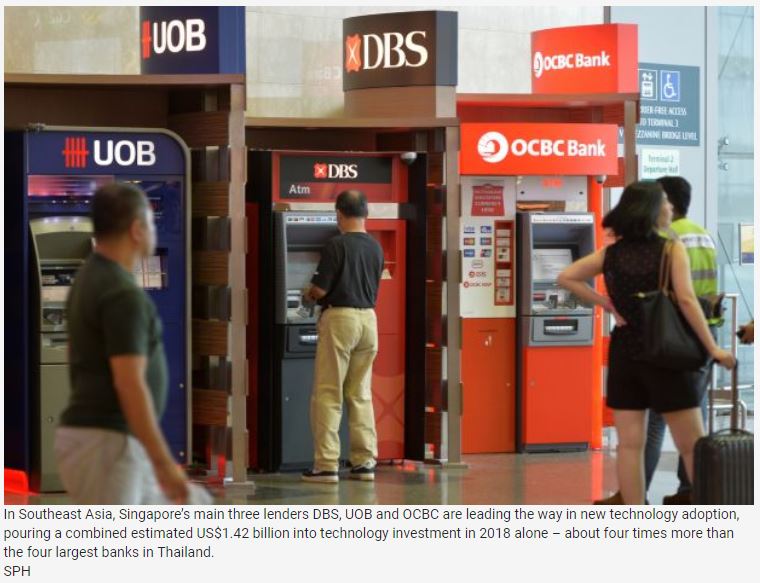Data will help ASEAN banks fend off challengers
The announcement in June that the Monetary Authority of Singapore (MAS) would allow up to five new digital banking licenses, coinciding with the Hong Kong Monetary Authority (HKMA) issuing a number of virtual banking licenses over past months, has served to reinforce the urgency for banks to automate and digitalise their businesses.
Central Banks and other regulators charged with liberalising banking systems clearly see the benefit in encouraging greater adoption of technology and digitalisation in the banking sector.
Malaysia and Philippine banks need to grow tech spend
A recent Accenture report on the largest 161 retail and commercial banks globally highlighted that digital leadership in banking drives superior economic performance and that banks which have embraced technology and digital transformation are rapidly outpacing those struggling with it.
Many of the region’s largest banks have been pushing their technology and digital agenda hard in recent years as they, like most banks globally, face a growing competitive threat from fintech and large-tech platform companies such as Alibaba, Google and Amazon. This has seen a rethink of business models and a pivot to digital and technology investment.
In Southeast Asia, Singapore’s main three lenders DBS, UOB and OCBC are leading the way in new technology adoption, pouring a combined estimated US$1.42 billion into technology investment in 2018 alone – about four times more than the four largest banks in Thailand.
Banks in Malaysia and the Philippines have perhaps the greatest gap to close in order to catch up to their Southeast Asia peers. According to Bloomberg Intelligence analyst Diksha Gera, operating cost ratios for Philippines banks, for example, are among the highest in the region as they still rely largely on traditional distribution channels and have lagged peers in other countries such as Indonesia in technology investment.
For Singapore banks who have been mostly focused on using technology to drive efficiencies up and costs down, they need to now turn their attention to finding new ways to grow their topline and differentiate their services. According to some banks, online customers can be twice as profitable as traditional consumers. Investment in technology is rapidly becoming a leading indicator of ability to capture future market share as it drives speed of response, quality of pricing and relevancy of customer interaction.
Data a critically important asset
As banks transform in a digital revolution, the derivation and quality of data used to ‘feed’ technology, automation and digital solutions has become a critically important asset.
According to recent comments by DBS Bank’s Chief Technology Officer Jimmy Ng, banks are going to win in the area of data analytics, as the fintechs still do not hold enough data on customers. Banks are also highly regulated in terms of keeping customer data safe.
Banks have had to get up to speed to understand how to capture data, interpret what it means and how it can be harnessed in a responsible and compliant way to ensure sound business strategies.
Bloomberg has seen first-hand how consistent data with standard identifiers improves efficiency across firms. The finance industry generates vast amounts of data and Bloomberg receives 100 billion market data messages a day. We firmly believe in the value of allowing clients to access data in the form they require and understand its composition. In addition, clients benefit from the ability to get all their data from one trusted provider.
For example, we work with several regional private banks to help front line relationship managers increasingly digitalising their workflow without needing to rely on their trading desks for pricing. They use this timely market information and price transparency to better service clients, provide access to more products and insights and efficiently execute on time-critical investment ideas.
With less data wrangling to deal with, banks can increase efficiency by working with harmonised, structured and clean data to draw actionable insights. In our own experience, we recognise that data needs to be easily utilized by both human engineers and machines. In both these use cases, the huge swathes of data necessary to compete need to be of the highest quality to populate machine learning algorithms.
There is no doubt that greater competition in the banking sector will spur continued innovation from new entrants and traditional ‘anchor’ banks alike. As financial systems evolve, customer-centric solutions driven by technology and digitalisation will increasingly be at the core of business strategy for those that want to remain leaders in the sector. Massive investment in technology and access to quality data will therefore no longer be an “if”, but a “must” in that continued transformation.
The writer is head of Asean at Bloomberg.


 English
English




